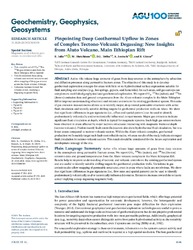Pinpointing Deep Geothermal Upflow in Zones of Complex Tectono-Volcanic Degassing: New Insights from Aluto Volcano, Main Ethiopian Rift
DOI: https://doi.org/10.1029/2019GC008309
Persistent URL: http://resolver.sub.uni-goettingen.de/purl?gldocs-11858/9382
Persistent URL: http://resolver.sub.uni-goettingen.de/purl?gldocs-11858/9382
Jolie, E.; Hutchison, W.; Driba, D.L.; Jentsch, A.; Gizaw, B., 2019: Pinpointing Deep Geothermal Upflow in Zones of Complex Tectono-Volcanic Degassing: New Insights from Aluto Volcano, Main Ethiopian Rift. In: Geochemistry, Geophysics, Geosystems, Band 20, 8: 4146 - 4161, DOI: 10.1029/2019GC008309.
 |
Dokument öffnen: |
Active rifts release large amounts of gases from deep sources to the atmosphere by advection and diffusion processes along permeable fracture zones. The objective of this study is to develop geothermal exploration concepts for areas with little or no hydrothermal surface expressions suitable for fluid sampling and analyses (e.g., hot springs, geysers, and fumaroles). In such areas, soil gas surveys can complement established geophysical and geochemical exploration. We report CO2, 222Rn (radon), and 220Rn (thoron) emission data and ground temperatures from the Aluto volcanic complex in the Main Ethiopian Rift to improve understanding of tectonic and volcanic controls on the existing geothermal system. This suite of gas emission measurements allows us to identify major, deep-rooted permeable structures with active fluid circulation and identify suitable drilling targets for geothermal production wells on Aluto. We show that significant differences in gas signatures (i.e., efflux and spatial pattern) can be used to identify predominantly volcanically and/or tectonically influenced compartments. Major gas emissions indicate significant fluid circulation at depth, which is typical for magmatic systems. Such high gas emissions have been observed in areas affected by major tectonic structures interacting with magmatic bodies at depth (tectono-volcanic). Predominantly fault-controlled sectors also show hydrothermal fluid circulation, but to a lower extent compared to tectono-volcanic sectors. Within the Aluto volcanic complex, geothermal production wells mainly target such fault-controlled domains, whereas results of the study indicate strongest fluid circulation in tectono-volcanic sectors. This result should be considered for the future exploration and development strategy of the site.
Statistik:
ZugriffsstatistikSammlung:
- Geologie [931]
This is an open access article under the terms of the Creative Commons Attribution License, which permits use, distribution and reproduction in any medium, provided the original work is properly cited.

